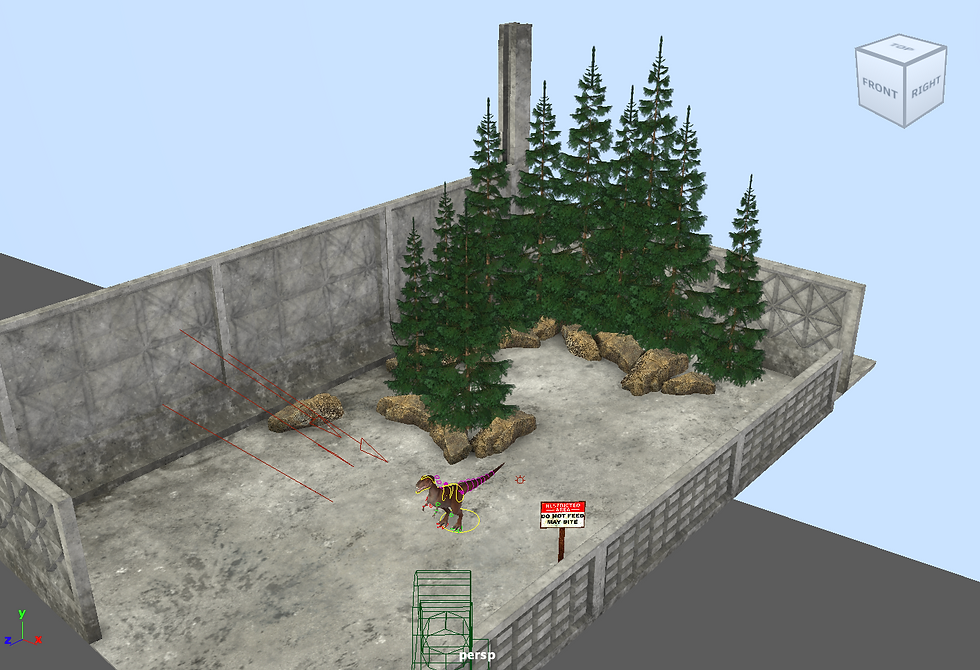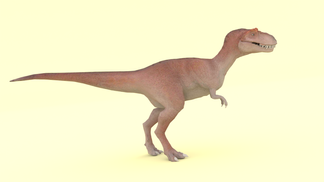Unit 8 : Dinosaur in motion
- Briony Davies
- Mar 10
- 6 min read
Updated: May 8
In this unit, we explore how to animate a dinosaur as it walks/stomps. Before this course, I have experimented with animating a walking dinosaurs but had some difficulty with it as I was unsure how to approach it. However, with the tutorials given, it was very clear how I should approach this animation and how to create a walk cycle of a bipedal creature that we have no live-action referencing from. It was very interesting to discover that we can look to birds such as Ostriches to help animate a dinosaur as not only being the closest living relative but similar anatomy (Attenborough and the Giant Dinosaur, 2016). It is also very similar to the idea that a horse has a walk cycle of half ostrich and half human, so the pattern of movement is already something familiar. There are some differences that, admittedly, took some time to understand. For example, the dinosaurs feet (or at least for this specific species of dinosaur) in the contact pose, both feet are touching the ground for more than one key pose. I'm more familiar with a walk cycle of one foot has contact and the other goes up. This was something I had to consider why to really understand this walk cycle. Dinosaurs have "large, muscular tails" (Dinosaurs, 2020), allowing them to balance and walk on two legs as their centre of body mass is above their feet/lower spine. This allowed for dominance due to their fast and powerful gait (Dinosaurs, 2020), therefore a bipedal dinosaur, such as the rig, needs to effectively showcase power, strength and predatory behaviour. Additionally, looking at Ostrich walk/runs was also key to help create some realism. I looked at Eadweard Muybridge's renowned photography of "Ostrich; Walking" 1872-1885 (Royal Academy of Arts), which helped breakdown each step and showcased how the joints in the legs work, as well as the motion of the body. It's important to remember here that this is just referring to and not copying, as Ostriches are light on their feet, have less muscular legs and do not have a tail. So it's a mix of the photography and theory to understand the structure.
The rig was created by Harry Gladwin Geoghegan, and it was a very clear and well-designed rig. The animation is on a 33-frame cycle, so not too dissimilar from the previous cycles I have worked on. The main poses were between frames 1-17, and I positioned the first leg according to the tutorial given. I then copied them over to the opposite leg.A difficult aspect of this animation is making the feet effectively "stomp." I struggled with this because I couldn't adequately emphasize the weight of the feet, but focused on this to get it as close as possible.After I key-framed the feet, I began animating the body and head rotations. I feel more confident each week, and my understanding of anatomical structures and motion gets clearer. For example, when the body moves upward, the head moves downward, or when the body rises, the arms lower, and so on. A thought-provoking quote from one of the tutorials that has resonated with me is Isaac Newton's Third Law: "For every action, there is an equal and opposite reaction" Space Center Houston (2022). I think this quote greatly enhanced my understanding of each action and movement of the body and how it affects the rest of the body. As usual, I put all the different controls on separate animation layers to help organize my work and isolate each body part I am working on. I applied pre and post infinity cycles to the animation so it looped seamlessly.
Once I had got the base animation strong and fluid, I moved onto the details such as some small and subtle rotations in the hips as each leg moves forward or back. It's not an obvious feature, but I believe it enhances the realism, and it's noticeable if it's not there. I also added toe "spreading" as the feet touch the ground and then take full weight of the body which helps create a natural feel about the walk.
I then brought the toe together when lifting off the ground. The tail of this rig was interesting to explore as it has a lot of controls on it which did become a challenge when adding multiple animations to it and then offseting it on certain controls of the tail. For example, I kept the first control of the tail as the same frames of the body, but the middle range of the controls were offset by 2 and the end controls were offset by 3, which enhanced the fluid movement of the tail, creating an overlapping action. I then went through the graph editor and smoothed out the tangents to create a smooth "wave" type pattern. Overall, I found this type of walk with this creature informative and a new experience. It enabled me to apply theory in practice, which I hope to utilise for animating other characters, such as fantasy creatures that lack real-life references, or of course other dinosaurs.

I created this scene using models from Turbosquid and placed them to create this concrete enclosure as if the dinosaur were at a zoo. I wanted to create an idea that the dinosaur is at first walking in a forest, to then zoom out and find it's in an enclosure. I enhanced this creature's liveliness by adding further animation at the end, just to round off the "story" and show the dinosaur roaring, as if it is announcing its presence. A technical attribute I used was baking out the frames. This has been very practical to use in order to make slight adjustments to certain frames, or change the sequence during the cycle, while still attaining a smooth and coherent walk. I have learned a lot using this tool, and appreciate its convenience and the impact it has on accelerating my animation time. Using the bake tool has not only simplified the process of creating animations but has also enhanced my overall efficiency in bringing my creative visions to life on another level. I used it to mainly create the intervals between the keyframes to slow the walk cycle and make the footsteps smaller until the dinosaur came to a natural stop. I didn't want to focus too much on this part of the animation as it's not what I'm trying to showcase, but I wanted it to look smooth and natural and try to be more creative with this cycle and all the methods and tools I have acquired so far.
The final animation
This is my final animation. I'm pleased with the outcome and believe I have understood this concept thoroughly, including the camera work to indicate the feet stomping. Upon my research, I discovered that dinosaurs, particularly predatory bipedal ones, are very stealthy on their feet and don't make noise or vibrations, but in cinema, they very much do (credit to Jurassic Park 1993), and I do very much admire this effect. It was interesting to explore this creature as, compared to previous animation cycles, the research and referencing were different, but there were still enough resources to guide me through the anatomical structure of a bipedal dinosaur, even if I couldn't discover which species of dinosaur this rig belongs to. As dinosaurs have strong muscular legs, I could develop this further in my animation by flexing various muscles to enhance a realistic and dynamic motion, as well as showcasing their natural dominance and predatory-like behavior. Aside from animation, I could also add some sound effects to push this narrative and really captivate the audience.
Reflections and Refinements
Looking at my work, I am pleased with how this animation came out and believe it is one of my strongest cycles so far. I think the cycle took me some time to plan and consider, but the rig was simple to navigate, enabling me to execute this walk cycle with minimal technical issues. Apart from rendering the scene out, I was unable to make improvements within the time frame of this module and make adjustments on my other animations as well, as I felt there were other animations that needed more focus. However, I still aim to make improvements based on feedback to enhance this animation and develop my own skills in dynamic creature animation. I put a side by side of the walk cycle to show the motions more clearly before showcasing the dinosaur in a scene and how it can be adapted for a more creative and engaging animation. I believe this demonstrates my expertise in using the Maya software and understanding of workflow and the production pipeline.
I was also interested in how animators who specialise in creatures or specifically dinosaurs work in the industry and the routes it leads to. Looking at Behind the Scenes: Killer Dinosaurs, Leonti, who works for the Motion Picture Company at the time of this interview, explains the process of the production in creating realistic dinosaurs for a documentary. It was insightful and informative that the animators work closely with scientists to model, texture, and animate the dinosaurs to get them as accurately as possible with the latest discoveries of this extinct creature. This demonstrates the crucial role of research in the creation process. It was also enlightening to learn that production operates in a chain-like manner, where each stage is completed and then handed off to the next specialist in a specific area (Leonti, 2014). Although this article is over a decade old, I believe it remains relevant to the industry and inspires me to enhance my research and reference skills to produce impactful animations that are in high demand.





















Comments